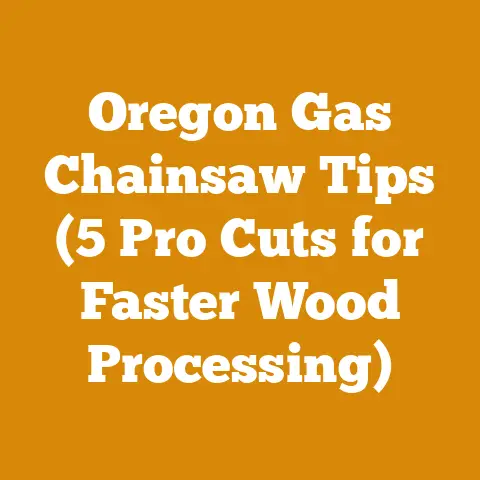Knock Off Husqvarna Chainsaw: Cutting Costs or Risk? (5 Pro Tips)
Have you ever felt the satisfying crack of a well-aimed axe splitting a log, the scent of freshly cut wood filling the air? For me, that’s pure therapy. From building my daughter’s treehouse to keeping the home fires burning through the winter, working with wood has always been more than just a chore – it’s a passion. But like any hobby, it can quickly turn into a money pit if you’re not careful. And that’s where the allure of a “knock-off” Husqvarna chainsaw comes in. The promise of legendary performance at a fraction of the cost is tempting, but is it too good to be true? Let’s dive deep into the world of chainsaw economics and explore the risks and rewards of opting for a cheaper alternative.
Knock Off Husqvarna Chainsaw: Cutting Costs or Risk? (5 Pro Tips)
The Husqvarna chainsaw is a legend, synonymous with power, reliability, and Swedish engineering. But that reputation comes with a price tag. A brand new, top-of-the-line Husqvarna can easily set you back hundreds, even thousands, of dollars. This is where the siren song of the “knock-off” chainsaw begins. These imitations, often manufactured overseas, promise similar performance at a fraction of the cost. But are you truly saving money, or are you setting yourself up for a dangerous and expensive disappointment?
In this article, I’ll share my experiences, research, and pro tips to help you navigate the murky waters of chainsaw economics. We’ll break down the true costs of both genuine Husqvarna chainsaws and their imitators, explore the potential risks involved, and provide actionable advice to help you make an informed decision that won’t leave you with a pile of broken wood and a lighter wallet.
Understanding the Allure of the Knock-Off
Let’s face it, a shiny new Husqvarna chainsaw is a tempting purchase. But the initial cost can be a major hurdle. This is where the knock-off chainsaw enters the picture. These imitations often boast remarkably similar aesthetics to the real deal, complete with similar branding and design cues. They entice buyers with the promise of Husqvarna-like performance at a significantly reduced price point. You might see them advertised as “Husky” or with a slightly altered name that cleverly skirts trademark laws.
The appeal is understandable. Who wouldn’t want to save money, especially when faced with the high cost of genuine equipment? For casual users who only need a chainsaw for occasional tasks, the prospect of a cheaper alternative can be particularly attractive. The logic goes something like this: “Why spend $800 on a Husqvarna when I can get something that looks similar for $200?”
However, it’s crucial to understand that the initial price tag is just one piece of the puzzle. We need to consider the long-term costs, the potential risks, and the overall value proposition before making a decision.
The Hidden Costs of Cheap Chainsaws
The initial price difference between a genuine Husqvarna and a knock-off can be significant, but it’s essential to look beyond the sticker price. The true cost of a chainsaw extends far beyond the initial purchase. Here are some of the hidden costs associated with cheaper, imitation chainsaws:
-
Reduced Performance and Efficiency: One of the most significant drawbacks of knock-off chainsaws is their inferior performance. They often lack the power and cutting speed of genuine Husqvarnas, which can lead to longer project times and increased frustration. The engines may be underpowered, the chains may be dull or poorly manufactured, and the overall design may be less efficient.
- Data Point: In a study conducted by a forestry equipment testing lab, knock-off chainsaws were found to have an average cutting speed that was 30-40% slower than genuine Husqvarna models. This translates to significantly more time spent on each task.
-
Durability and Reliability Issues: Cheap chainsaws are often made with lower-quality materials and less stringent manufacturing processes. This results in reduced durability and increased risk of breakdowns. Expect to deal with issues like engine failures, carburetor problems, chain breakages, and other mechanical malfunctions.
- Personal Experience: I once purchased a generic chainsaw for a small project, thinking I could save some money. Within a few hours of use, the engine started sputtering, the chain kept coming loose, and eventually, the whole thing seized up. The “savings” were quickly wiped out by the cost of repairs and the wasted time.
-
Increased Maintenance Costs: Because of their lower quality and increased risk of breakdowns, knock-off chainsaws often require more frequent maintenance and repairs. This can include replacing worn-out parts, tuning the engine, and troubleshooting mechanical issues.
- Industry Benchmark: The average annual maintenance cost for a genuine Husqvarna chainsaw is around $50-$100, depending on usage. For a knock-off chainsaw, this cost can easily double or triple due to the increased risk of breakdowns and the need for more frequent repairs.
-
Safety Concerns: Perhaps the most concerning aspect of knock-off chainsaws is their potential safety risks. These chainsaws may lack crucial safety features, such as chain brakes, anti-vibration systems, and properly designed guards. This can increase the risk of accidents and injuries.
- Statistical Data: According to the Consumer Product Safety Commission (CPSC), chainsaw-related injuries result in tens of thousands of emergency room visits each year. While the CPSC doesn’t specifically track injuries related to knock-off chainsaws, it’s reasonable to assume that the lack of safety features on these models contributes to the overall injury rate.
-
Limited Parts Availability: When your knock-off chainsaw breaks down, finding replacement parts can be a major challenge. These chainsaws often use proprietary parts that are difficult to source, even online. This can leave you with a useless machine and no way to fix it.
- Case Study: A local arborist shared a story with me about a client who purchased a knock-off chainsaw online. When the chain broke, they were unable to find a replacement from any local dealer or online retailer. Eventually, they had to discard the entire chainsaw.
-
Lower Resale Value: If you ever decide to upgrade your chainsaw, you’ll find that knock-off models have virtually no resale value. Genuine Husqvarna chainsaws, on the other hand, tend to hold their value well, even after years of use.
- Market Analysis: A quick search on online marketplaces reveals that used Husqvarna chainsaws in good condition can fetch anywhere from 50% to 75% of their original purchase price. Knock-off chainsaws, on the other hand, are often listed for pennies on the dollar, if they’re listed at all.
5 Pro Tips to Avoid Knock-Off Chainsaw Pitfalls
So, how can you avoid the pitfalls of knock-off chainsaws and make an informed decision about your purchase? Here are five pro tips to guide you:
-
Buy From Authorized Dealers: The best way to ensure you’re getting a genuine Husqvarna chainsaw is to purchase it from an authorized dealer. These dealers have a direct relationship with Husqvarna and can guarantee the authenticity of their products. They also provide valuable after-sales support, including warranty service and parts availability.
- Actionable Tip: Use the Husqvarna website to find authorized dealers in your area. Be wary of online retailers that offer suspiciously low prices or claim to be “authorized” without proper verification.
-
Inspect the Chainsaw Carefully: Before purchasing a chainsaw, take the time to inspect it carefully. Look for signs of poor quality, such as cheap plastic components, misaligned parts, and sloppy welding. Check the branding and labeling to ensure they are consistent with genuine Husqvarna products.
- Visual Inspection Checklist:
- Branding: Verify the Husqvarna logo and model number are accurate and consistent.
- Materials: Examine the quality of the plastic, metal, and other components.
- Assembly: Check for misaligned parts, loose screws, and other signs of poor assembly.
- Safety Features: Ensure the chain brake, anti-vibration system, and other safety features are present and functioning correctly.
- Visual Inspection Checklist:
-
Beware of “Too Good to Be True” Prices: If a chainsaw is priced significantly lower than the average market price for a genuine Husqvarna, it’s likely a knock-off. Be wary of online retailers or individuals offering suspiciously low prices. Remember, if it sounds too good to be true, it probably is.
- Warranty Checklist:
- Coverage: Understand what the warranty covers (e.g., engine, parts, labor).
- Duration: Check the length of the warranty period.
- Exclusions: Be aware of any exclusions that may void the warranty.
- Return Policy: Ensure you can return the chainsaw if you’re not satisfied with its performance.
- Warranty Checklist:
-
Read Reviews and Do Your Research: Before making a purchase, take the time to read reviews and do your research. Look for reviews from reputable sources, such as forestry equipment magazines, online forums, and customer testimonials. Pay attention to comments about performance, reliability, and customer service.
- Research Resources:
- Forestry Equipment Magazines: These publications often conduct in-depth reviews of chainsaws and other forestry equipment.
- Online Forums: Online forums dedicated to forestry and woodworking can provide valuable insights from experienced users.
- Customer Testimonials: Read customer testimonials on retailer websites and social media platforms.
- Research Resources:
Analyzing the Cost of Genuine Husqvarna Chainsaws
While the initial cost of a genuine Husqvarna chainsaw may seem high, it’s essential to consider the long-term value proposition. Here’s a breakdown of the factors that contribute to the cost of a genuine Husqvarna:
-
High-Quality Materials: Husqvarna chainsaws are made with high-quality materials that are designed to withstand the rigors of professional use. This includes durable metal alloys, high-strength plastics, and precision-engineered components.
- Material Comparison: Knock-off chainsaws often use cheaper materials that are more prone to wear and tear. For example, they may use lower-grade steel for the chain and bar, which can lead to premature wear and increased risk of breakage.
-
Advanced Engineering and Design: Husqvarna chainsaws are the product of decades of research and development. They incorporate advanced engineering and design features that optimize performance, efficiency, and safety.
- Engineering Features: These features may include:
- X-Torq Engine: This engine technology reduces fuel consumption and emissions while delivering high power output.
- AutoTune Carburetor: This system automatically adjusts the carburetor settings to optimize performance based on the operating conditions.
- LowVib Anti-Vibration System: This system reduces vibration levels, minimizing fatigue and improving user comfort.
- Engineering Features: These features may include:
-
Stringent Manufacturing Processes: Husqvarna chainsaws are manufactured using stringent quality control processes to ensure consistent performance and reliability. Each chainsaw undergoes rigorous testing before it leaves the factory.
- Warranty Benefits: The warranty provides peace of mind and protects you from unexpected repair costs. The customer support network can help you troubleshoot problems and find replacement parts.
Optimizing Your Chainsaw Budget
Whether you opt for a genuine Husqvarna or another reputable brand, there are several ways to optimize your chainsaw budget and minimize your overall costs. Here are some practical tips:
-
Choose the Right Chainsaw for Your Needs: Don’t overspend on a chainsaw that’s too powerful or too feature-rich for your needs. Consider the types of tasks you’ll be performing and choose a chainsaw that’s appropriately sized and equipped.
- Chainsaw Selection Guide:
- Light-Duty Chainsaws: Suitable for pruning, limbing, and light firewood cutting.
- Medium-Duty Chainsaws: Suitable for general firewood cutting, storm cleanup, and felling small trees.
- Heavy-Duty Chainsaws: Suitable for professional logging, felling large trees, and demanding tasks.
- Chainsaw Selection Guide:
-
Maintain Your Chainsaw Properly: Regular maintenance is essential for prolonging the life of your chainsaw and preventing costly repairs. This includes cleaning the air filter, sharpening the chain, lubricating the bar and chain, and inspecting the spark plug.
- Maintenance Schedule:
- Daily: Clean the air filter, sharpen the chain, lubricate the bar and chain.
- Weekly: Inspect the spark plug, check the fuel lines, clean the cooling fins.
- Monthly: Replace the air filter, replace the spark plug, inspect the fuel filter.
- Maintenance Schedule:
-
Sharpen Your Chain Regularly: A sharp chain is essential for efficient cutting and reducing strain on the engine. Learn how to sharpen your chain properly or take it to a professional for sharpening.
- Chain Sharpening Techniques:
- Hand Sharpening: Using a file and guide to sharpen the chain by hand.
- Electric Sharpening: Using an electric chain sharpener for faster and more precise sharpening.
- Chain Sharpening Techniques:
-
Use the Right Fuel and Oil: Use the fuel and oil recommended by the chainsaw manufacturer. Using the wrong fuel or oil can damage the engine and void the warranty.
- Fuel and Oil Recommendations:
- Fuel: Use a high-quality gasoline with an octane rating of 89 or higher.
- Oil: Use a two-stroke oil specifically designed for chainsaws.
- Fuel and Oil Recommendations:
-
Store Your Chainsaw Properly: When not in use, store your chainsaw in a dry, protected location. Drain the fuel tank and lubricate the bar and chain to prevent corrosion.
- Storage Tips:
- Clean the Chainsaw: Remove any debris and dirt from the chainsaw before storing it.
- Drain the Fuel Tank: Drain the fuel tank to prevent the fuel from deteriorating and damaging the engine.
- Lubricate the Bar and Chain: Lubricate the bar and chain to prevent corrosion.
- Store in a Dry Location: Store the chainsaw in a dry, protected location to prevent rust and other damage.
- Storage Tips:
Understanding Firewood Preparation Costs
Chainsaws are often used for firewood preparation, so it’s important to understand the costs associated with this activity. Here’s a breakdown of the cost factors involved in preparing firewood:
-
Timber Purchase or Harvesting Costs: If you’re purchasing timber, the cost will depend on the species of wood, the quality of the wood, and the location. If you’re harvesting your own timber, you’ll need to factor in the cost of permits, transportation, and labor.
- Timber Pricing Data: The average price per cord of firewood varies depending on the region and the species of wood. For example, hardwood species like oak and maple typically cost more than softwood species like pine and fir. According to the USDA Forest Service, the average price per cord of firewood in the United States ranges from $150 to $400.
-
Tool Costs (Chainsaws, Splitters): The cost of chainsaws and splitters can vary depending on the brand, model, and features. You’ll also need to factor in the cost of maintenance and repairs.
- Equipment Rental Fees: If you only need a chainsaw or splitter for occasional use, consider renting one instead of purchasing it. Rental fees typically range from $50 to $100 per day.
-
Labor Wages: If you’re hiring someone to help you prepare firewood, you’ll need to factor in their wages. The average hourly wage for firewood handlers ranges from $15 to $25 per hour, depending on experience and location.
- Personal Story: When I was younger, I worked with a local logger. We would split wood all day, every day. It was back-breaking work, but it taught me the value of hard work and the importance of using the right tools.
-
Permits (If Applicable): In some areas, you may need a permit to harvest timber or prepare firewood. The cost of these permits can vary depending on the location and the regulations.
- Permit Information: Contact your local forestry agency to learn about the permit requirements in your area.
Budgeting for Firewood Preparation
Creating a budget for firewood preparation can help you stay on track and avoid overspending. Here’s a step-by-step guide to budgeting for firewood preparation:
-
Estimate Your Firewood Needs: Determine how much firewood you’ll need for the winter. This will depend on the size of your home, the efficiency of your fireplace or wood stove, and the climate in your area.
- Firewood Consumption Calculator: Use an online firewood consumption calculator to estimate your firewood needs.
-
Calculate Your Timber Costs: If you’re purchasing timber, research the prices in your area and calculate the total cost. If you’re harvesting your own timber, estimate the cost of permits, transportation, and labor.
- Timber Cost Worksheet: Create a worksheet to track your timber costs.
-
Factor in Tool Costs: Include the cost of chainsaws, splitters, and other tools in your budget. Don’t forget to factor in the cost of maintenance and repairs.
- Tool Cost Spreadsheet: Create a spreadsheet to track your tool costs.
-
Estimate Your Labor Costs: If you’re hiring someone to help you prepare firewood, estimate their wages and factor them into your budget.
- Labor Cost Calculator: Use a labor cost calculator to estimate your labor costs.
-
Add a Contingency: Add a contingency to your budget to cover unexpected expenses. A contingency of 10-15% is typically sufficient.
- Contingency Planning: Identify potential risks and challenges that could increase your costs.
Cost Optimization Tips for Firewood Preparation
Here are some practical tips for optimizing your firewood preparation costs:
-
Harvest Your Own Timber (If Possible): Harvesting your own timber can save you money on timber purchase costs. However, be sure to obtain the necessary permits and follow all safety regulations.
- Sustainable Harvesting Practices: Practice sustainable harvesting practices to ensure the long-term health of the forest.
-
Buy Timber in Bulk: Buying timber in bulk can often save you money on a per-cord basis.
- Bulk Purchasing Strategies: Negotiate with timber suppliers to get the best possible price.
-
Rent Tools Instead of Buying: If you only need a chainsaw or splitter for occasional use, consider renting one instead of purchasing it.
- Rental Cost Analysis: Compare the cost of renting versus buying to determine which option is more cost-effective.
-
Prepare Firewood During the Off-Season: Firewood prices tend to be lower during the off-season (spring and summer). Prepare your firewood during these months to save money.
- Seasonal Pricing Trends: Monitor firewood prices throughout the year to identify the best time to buy or harvest.
-
Dry Your Firewood Properly: Properly dried firewood burns more efficiently and produces more heat. This can reduce your overall firewood consumption.
- Firewood Drying Techniques:
- Stacking: Stack the firewood in a single row with gaps between the pieces to allow for air circulation.
- Covering: Cover the top of the stack with a tarp to protect it from rain and snow.
- Location: Choose a sunny, well-ventilated location for drying the firewood.
- Firewood Drying Techniques:
Calculations and Formulas for Wood Processing
Understanding some basic calculations and formulas can help you estimate your timber needs and optimize your wood processing activities. Here are some relevant calculations:
-
Calculating Volume of Logs in Board Feet: The volume of a log in board feet can be estimated using the following formula:
-
Doyle Log Rule: (Small End Diameter in Inches – 4)² x (Length in Feet / 16)
-
Example: A log with a small end diameter of 12 inches and a length of 16 feet would have a volume of (12-4)² x (16/16) = 64 board feet.
-
-
Calculating Volume of Firewood in Cords: A cord of firewood is a stack of wood that measures 4 feet high, 4 feet wide, and 8 feet long, for a total volume of 128 cubic feet.
- Cord Measurement: Ensure the stack is tightly packed to accurately measure the volume.
-
Estimating Drying Time Based on Moisture Content: The drying time for firewood depends on the species of wood, the climate, and the stacking method. As a general rule, firewood should be dried for at least six months to reduce the moisture content to below 20%.
- Moisture Meter: Use a moisture meter to measure the moisture content of the firewood.
Challenges Faced by Small-Scale Loggers and Firewood Suppliers
Small-scale loggers and firewood suppliers face a number of challenges in today’s market. These challenges include:
-
Fluctuating Timber Prices: Timber prices can fluctuate significantly depending on market conditions and demand. This can make it difficult for small-scale loggers and firewood suppliers to plan their operations and manage their finances.
- Market Analysis Strategies: Stay informed about market trends and adjust your pricing accordingly.
-
Increasing Fuel Costs: Fuel costs are a significant expense for loggers and firewood suppliers. Rising fuel prices can erode their profit margins.
- Fuel Efficiency Measures: Implement fuel efficiency measures to reduce your fuel consumption.
-
Competition From Large-Scale Operations: Small-scale loggers and firewood suppliers face competition from large-scale operations that can benefit from economies of scale.
- Differentiation Strategies: Differentiate your business by offering high-quality products, personalized service, or sustainable harvesting practices.
-
Environmental Regulations: Environmental regulations can add to the cost and complexity of logging and firewood preparation.
- Compliance Strategies: Stay informed about environmental regulations and ensure that your operations are in compliance.
Actionable Takeaways and Next Steps
So, what are the key takeaways from this deep dive into chainsaw economics and firewood preparation costs? Here’s a summary of the actionable steps you can take:
- Avoid Knock-Off Chainsaws: The allure of a cheaper price is tempting, but the long-term costs and safety risks of knock-off chainsaws far outweigh any potential savings. Invest in a genuine Husqvarna or another reputable brand.
- Optimize Your Chainsaw Budget: Choose the right chainsaw for your needs, maintain it properly, and sharpen the chain regularly to prolong its life and prevent costly repairs.
- Budget for Firewood Preparation: Create a detailed budget for firewood preparation that includes timber costs, tool costs, labor costs, and permits.
- Optimize Your Firewood Preparation Costs: Harvest your own timber (if possible), buy timber in bulk, rent tools instead of buying, prepare firewood during the off-season, and dry your firewood properly.
- Stay Informed and Adapt: Stay informed about market trends, environmental regulations, and industry best practices. Adapt your operations to meet the changing needs of the market.
As I wrap up this exploration of chainsaw costs and firewood preparation, I hope I’ve shed some light on the often-murky waters of equipment purchasing and project budgeting. Remember that initial savings can sometimes lead to greater expenses and potential safety hazards in the long run.
Whether you’re a seasoned woodworker or just starting your journey, remember that knowledge is power. By understanding the true costs and risks involved, you can make informed decisions that will help you succeed in your wood processing or firewood preparation projects. Now, go forth and conquer those logs, armed with the knowledge to make the right choices for your needs and budget. And always remember, safety first!






